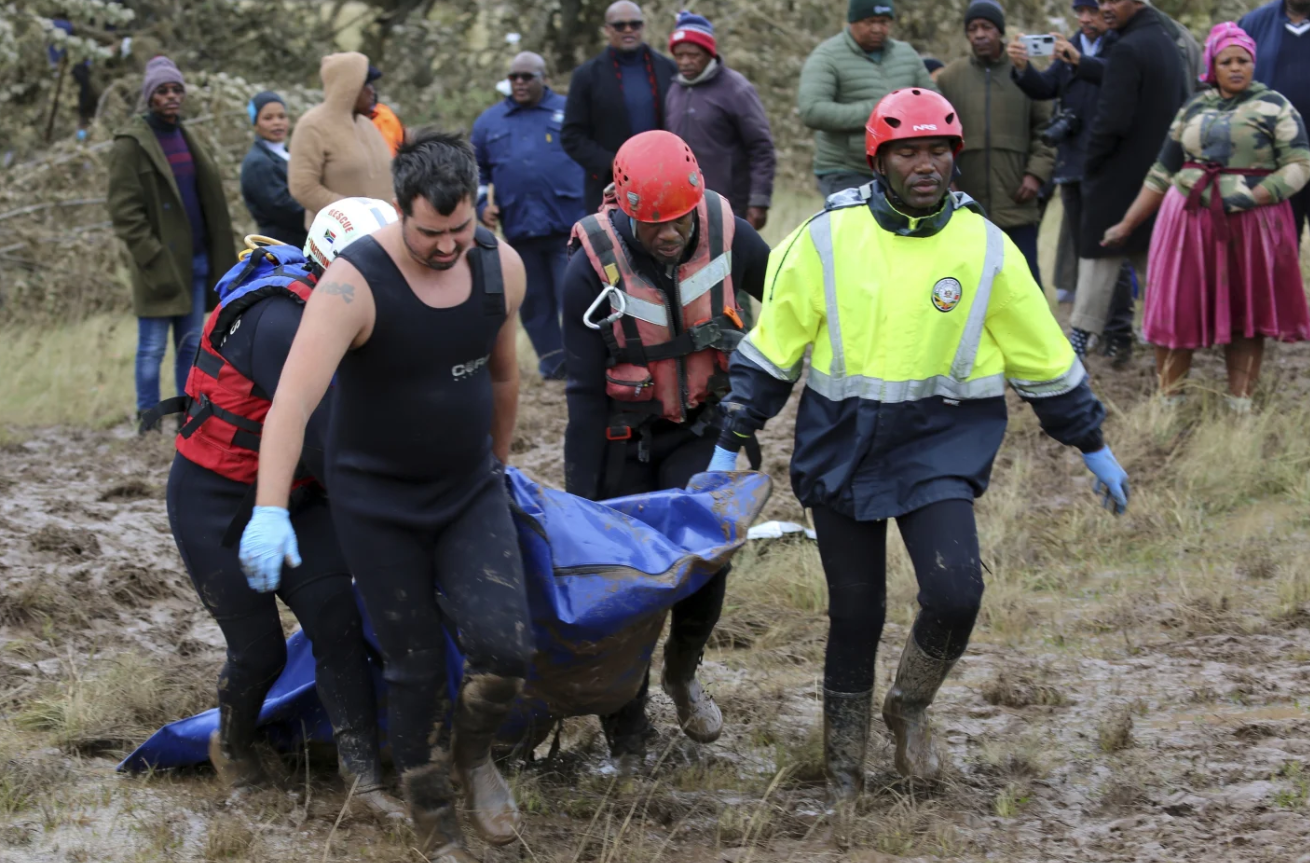South Africa Flood Disaster: Death Toll Rises to 49 as Eastern Cape Battles Worst Weather in Years
At least 49 people are dead and dozens missing after floods devastated South Africa’s Eastern Cape province, prompting urgent rescue efforts.

JOHANNESBURG, South Africa (WE) — At least 49 people have died as devastating floods tore through Eastern Cape province, one of South Africa’s poorest regions. According to officials, the death toll is likely to rise as search efforts continue.
The floods began early Tuesday after a fierce cold front slammed into the country’s southeastern region. The storm brought heavy rainfall, gale-force winds, and unexpected snowfall. In particular, the area surrounding the town of Mthatha suffered the greatest damage, with rivers overflowing and entire communities submerged.
Premier Oscar Mabuyane of the Eastern Cape confirmed the fatalities during a press conference. “As we speak, more bodies are being discovered,” he said solemnly. “This is one of the worst disasters we’ve ever experienced.”
Six high school students lost their lives when floodwaters engulfed their school bus near a river close to Mthatha. Rescue teams located the bus on Wednesday, but it was already empty. Fortunately, they had saved three students the day before after finding them clinging to trees and shouting for help. The flood also claimed the lives of the bus driver and an adult supervisor. As of now, four students are still missing.
Importantly, the Eastern Cape is not facing this disaster alone. National and local search-and-rescue teams continue operations, hoping to locate survivors and recover more bodies. Authorities have not confirmed how many individuals remain unaccounted for. However, they are collaborating closely with families to identify the missing.
In the wake of the flood, damage assessments paint a grim picture. According to the Eastern Cape Department of Education, 58 schools suffered extensive damage, including collapsed walls, flooded classrooms, and destroyed equipment. Additionally, 20 hospitals were affected, with some patients having to be evacuated due to power failures and structural risks.
Meanwhile, the humanitarian crisis is escalating. Hundreds of families have lost their homes and now live in emergency shelters such as churches, schools, and community halls. Makeshift beds, food supplies, and clean water are scarce. In response, organizations like Gift of the Givers and the South African Red Cross have stepped in to provide aid.
Moreover, President Cyril Ramaphosa issued a public statement expressing his condolences. He described the floods as “devastating” and said that the National Disaster Management Center had activated full support. “We are doing everything we can to assist the province,” he assured.
The weather system responsible for this destruction was more intense than usual. Meteorologists at the South African Weather Service (SAWS) explained that some regions received over 100 millimeters of rain in a single day. Furthermore, parts of the Free State and KwaZulu-Natal experienced heavy snowfall, compounding the crisis.
Not only did the floods cause direct fatalities, but they also triggered mudslides and power outages across two provinces. As a result, hundreds of thousands of homes in Eastern Cape and KwaZulu-Natal were left without electricity. Technicians from Eskom are working tirelessly to restore power, but progress remains slow due to the scale of the damage.
In many neighborhoods, the aftermath is visible. Entire streets are caked in mud, with cars piled up against buildings and trees. Some homes were flattened, while others remain submerged under water. Roadways are impassable, which has delayed the delivery of relief supplies to affected communities.
Although the storm has passed, its consequences will linger. Officials have already declared a provincial disaster, which enables quicker access to national funds. Still, rebuilding will be a monumental challenge—especially in rural regions that were already struggling with poverty and underdevelopment.
In fact, Eastern Cape is among the most impoverished areas in South Africa. Infrastructure is fragile, unemployment is high, and many homes are built without formal construction permits. Because of this, informal settlements suffered the most during the flood. In these communities, homes built with scrap materials collapsed instantly under the force of the water.
Read More:
- South Korea Silences Border Loudspeakers in First Step Toward Easing Tensions with North Korea
- Explosions Rock Southwest Colombia, Killing at Least Seven in Police-Targeted Attacks
- Greta Thunberg Deported from Israel After Attempting to Break Gaza Blockade, Condemns ‘War Crimes’
Elsewhere in the country, other provinces also felt the storm’s impact. In Pietermaritzburg, strong winds tore off roofs and knocked down trees. In Newcastle, snow created travel chaos. The N3 Highway connecting Johannesburg and Durban was temporarily closed due to ice and debris.
Additionally, Dr. Thandi Mkhize, a forecaster with SAWS, said, “We warned of an extreme cold front last week. However, few expected it to be this severe. We saw rainfall, snow, and wind all at once, which is rare.”
The flooding also revealed deep-rooted inequalities. As experts like Dr. Chris Jack from the University of Cape Town note, poor urban planning and climate vulnerability have made disasters more deadly. “Climate change is intensifying storms,” he said. “But it’s poverty that turns them into catastrophes.”
Nevertheless, communities have shown remarkable resilience. In Mthatha, residents are volunteering to clear debris, distribute food, and support displaced families. Churches have opened their doors to flood victims. Local radio stations are broadcasting updates and missing persons reports.
Importantly, the government has pledged to review disaster preparedness strategies. Premier Mabuyane stressed the need for better housing standards and early warning systems. “This cannot happen again,” he said. “We must learn and build back stronger.”
Despite the hardship, there are stories of survival. Children were pulled from trees. Families escaped through rooftops. Strangers helped strangers.
Rescue efforts continued into Thursday. Helicopters scouted remote areas, while search dogs and divers combed rivers and valleys. Yet, hope is fading for the dozens who are still missing.
In shelters, families mourned. Teachers lit candles for their students. Community leaders organized memorials. Across the country, people have begun raising funds for the victims and their families.
Historically, South Africa has struggled with extreme weather. In 2022, Durban faced floods that claimed over 400 lives. Today, similar scenes are unfolding in Eastern Cape. This time, however, the disaster could spark change.
For now, the priority is saving lives and helping survivors. But in the long term, officials, scientists, and citizens alike must confront a tough truth: climate resilience and social equity are no longer optional—they are essential.















